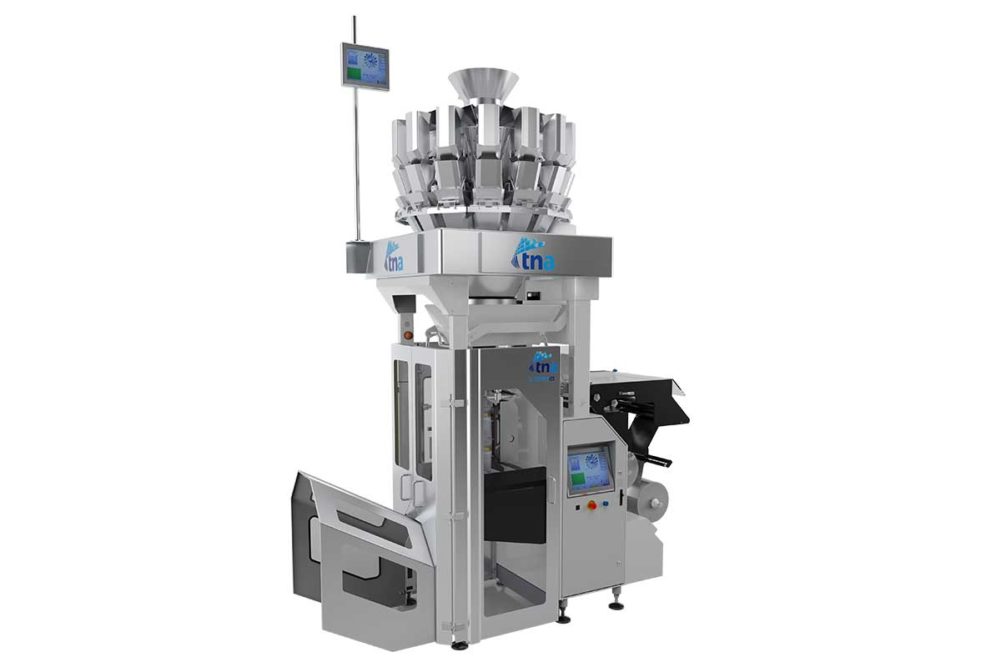Variety packaging has largely been a manual process. Filling a variety pack often required human beings to pick and place the different flavors of chips, pretzels, bars or other snacks into the secondary packaging. This is where the manpower comes into play. Robotic technology, however, can streamline the operation.
“Robotic solutions help by accurately putting together variety packs as they verify the product to ensure the correct product and quantity is picked,” said Wes Bryant, product team leader for AMF Workhorse. “This removes the chance of the operator mis-picking and placing the incorrect product in the pack. It also allows for consistently building packages without the need for extensive training of new employees or constant quality checks.”
Automated work cells, which consist of an entire section of a production line that needs no human interaction, can automatically supply packaging and products to that section of the production line without manpower, therefore removing the opportunity for any human errors, Mr. Bryant explained.
Pairing robots with line tracking and vision systems has further increased their accuracy and speed. Robotics are also safer today, making them less intimidating for food manufacturers to adopt.
“The introduction of cobots with motion sensors has made it possible to safely work alongside humans,” said Jamie Bobyk, marketing manager, Apex Motion Control. “Unlike large stationary robotic systems that move very fast, need to be caged or guarded, and require a certain amount of floorspace, cobots move much slower and less aggressively with the added benefit of mobility; they can be moved station to station as needed.”
Apex Motion’s Baker-Bots, for example, can sense when a human is approaching within a certain field of vision and slow its arm movement to a stop. The Baker-Bot won’t start again until the person has safely left the area, enabling humans and robotics to mingle on a production room floor.
Not only can robots and cobots pick and place product into its secondary packaging, but the entire packaging process can be done by robots, pointed out Stefan Hoffman, sales account manager, Schubert North America.
“From erecting cartons and cases to creating the requested mix of flavors and loading those products into cartons and cases to closing — the entire process can be done by robots, which tremendously reduces the amount of labor while also increasing efficiency and accuracy,” he said.
One of the biggest reasons it has been difficult to automate variety pack assembly is the level of flexibility required. Human hands and eyes have been the most reliable at adapting to different products as they go into secondary packaging. And the product portfolios are only getting more diverse in size and shape.
“Mass customization is a definitive development for the packaging industry,” said Michael Graf, director of consulting at Schubert Packaging Systems. “Product variety is constantly increasing, not only in terms of the product itself but also in terms of packaging variety and personalization options. This means that the production units are becoming smaller and more frequent tooling is required. Manufacturers therefore are increasingly in need of highly flexible packaging machines that allow easy, fast format changes and are then immediately read for use again.”
When developing a flexible packaging line, it starts with the products. Being able to pack different products with different sizes in different configurations comes down to the tooling of the machines, specifically the end effectors. The end effectors for today’s robotics are giving human operators stiff competition. During the past 10 years, end effector design has grown in sophistication, allowing them to pick up smaller, more delicate products. And their ability to quickly change out has also improved.
“The pick-and-place machines can easily switch between plastic and cardboard trays,” said Martin Sauter, head of sales at Gerhard Schubert GmbH. “An almost unlimited number of formats with and without trays can be implemented with Schubert technology, and the variable image processing monitors product quality in 3D.”
Mr. Sauter was quick to point out, however, that the versatile mechanics are only one part of building a flexible packaging line.
“We consider the mechanics, electronics and software as an integrated system, whose variability is ultimately mapped in the VMS packaging machine control system,” Mr. Sauter said.
These technologies come together to create systems that can efficiently assemble variety packs and then change quickly to adapt to changes in configuration and product.
“Sometimes a very quick change of end effectors may be required depending on the package size,” Mr. Bobyk pointed out. “Vision-based robotics and cobots can now safely work alongside human workers and be programmed with many different recipes. Meaning that by using a touch screen such as you would find on an Apex Motion Control Baker-Bot Cobot, it’s just a matter of clicking through the menu like you would on a tab, selecting the new recipe — in this case, pack size and configuration — and away you go.”
Beyond end effectors, electronics and software, modularity also can come into play as various types of primary, secondary and tertiary packaging all require different pieces of equipment.
“Different pack sizes, individual products, variable product configurations, cardboard, flowpacks or trays made of different materials — these are all variants that we can implement on the same machine thanks to modular technology,” Mr. Sauter explained.
This article is an excerpt from the September 2022 issue of Baking & Snack. To read the entire feature on Snack Packaging, click here.






